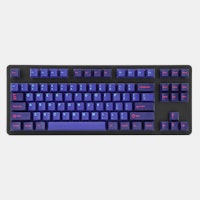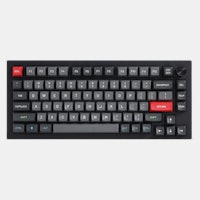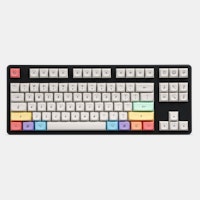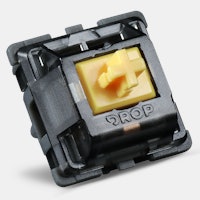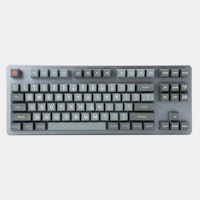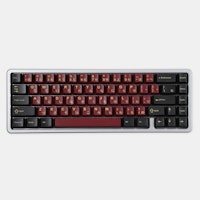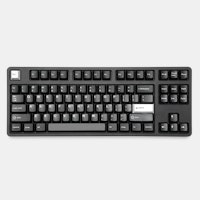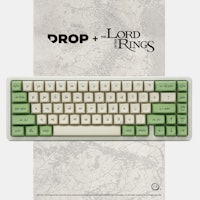Click to view our Accessibility Statement or contact us with accessibility-related questions






Don't Buy A Mechanical Keyboard... Yet
My mechanical keyboard journey started when I fell into the rabbit hole around August 2020. Since then, I have tested over forty different switches, built or modified over twenty keyboards, and experimented with many different layouts. I usually carry a mechanical keyboard with me, and have built keyboards for friends and family members. Many consider mechanical keyboards superior to normal membrane keyboards due to their feel, sound, looks, layout options, software, and various customization options. While many swear by mechanical keyboards, they are expensive, and the landscape of mechanical keyboards is confusing and hard to navigate. That said, if you do decide to look into and possibly build one, here is some more information to guide you through the rabbit hole.
The first thing you will probably notice while looking through videos about mechanical keyboards is the sound. Many people build their custom keyboards with sound in mind, and because of this there are endless jargon words for describing how a keyboard sounds. This is where it starts getting confusing. Words such as “thocky”, “clacky”, “creamy”, “marbly”, and “poppy” are all buzzwords that are thrown around endlessly in a hopeless attempt to describe how a keyboard sounds. None of these buzzwords have concrete definitions, leading to people using the same word to describe anything and everything. For example, a keyboard that one person considers “thocky” could be classed as “clacky” by another. Even terms that are seen as more objective, such as “higher-pitched” and “lower-pitched” are no help as there is nothing to reference. This is only slightly remedied using comparisons, but while comparisons are helpful for sound, they are absolutely useless when it comes to describing how a switch feels.
Some keyboard terminology should be defined before diving deeper into the world of mechanical keyboards. To start, what makes a mechanical keyboard “mechanical”? Unlike membrane keyboards that use an electro-capacitive rubber membrane to actuate keys, mechanical keyboards use discrete mechanical switches inserted onto a printed circuit board, or PCB. Each switch has a metal contact inside them which completes a circuit when pressed.
Switches are the main reason that mechanical keyboards can sound and feel very different from one another. Most mechanical switches today are “MX-style”, which are created based on the once-patented Cherry MX design. There are 3 main categories of MX-style switches: linear, tactile, and clicky. Linear switches press straight down, similar to a piano key. Tactile switches are most similar to a membrane keyboard, and have a tactile event, or “bump”, in the middle of the keypress. Lastly, clicky switches also have a tactile bump and produce an audible “click” sound, hence the name. There is a large variety of linear, tactile, and clicky switches made by different manufacturers which all sound, feel, and/or look different.
In the above section about switches, parallels were given to exemplify what each type of switch feels like. The accuracy of these parallels vary from person to person. This gets worse when realizing that different keyboards have different mounting styles which result in “softer” or “stiffer” typing experiences. As I dived deeper into the rabbit hole, I experienced different keyboards and switches, allowing me to notice and love the nuances between different switches and mounting styles. From a beginner perspective, however, all the jargon and buzzwords are beyond confusing. The internet is vast, and it’s difficult to know what information is credible without prior knowledge. Most beginner guides, whether written or video, focus on specific keyboards or specific aspects of keyboards. It’s not all bad however, and I have found that subreddits such as r/mechanicalkeyboards and discord groups by YouTube creators like Taeha Types and Andy V Nguyen are quite active, and members of those reddit and discord groups are generally quite helpful when it comes to beginner questions.
Other than switch options, another reason for people to opt for mechanical keyboards is layout options. Layout refers to the size and shape of the keyboard, which also affects the number of keys the keyboard has. For example, the traditional full-sized keyboard has around 104-108 keys, and is complete with the function row to the top and the navigation cluster and number pad on the right. Removing the number pad on the right yields the 80% layout, more commonly known as the tenkeyless or TKL layout. Going a step further and removing the function row and navigation cluster leaves us with the 60% layout. Of course, as if this wasn’t confusing enough, there are more percentages and jargon words to discover.
Yet another reason that people prefer mechanical keyboards over membrane keyboards is the option to use software to further customize the keyboard. Many gaming companies have their proprietary softwares for their keyboards, and most custom keyboard kits now come with PCBs flashed with VIA. VIA is an open source software that makes remapping keys a breeze, and you can read more about it on their website. The flexibility that VIA provides was a big reason for me to use mechanical keyboards, and all of my keyboards now have macros that input my email addresses. VIA only became more useful as I started to experiment with smaller keyboard layouts such as 65% and 60% keyboards.
Mechanical keyboards aren’t without their flaws, chief among them is that they are expensive. Membrane keyboards can easily be obtained for a couple of dollars or even for free. On the other hand, even the cheapest mechanical keyboards, like offerings from Royal Kludge or MageGee, are around $30 USD. This quickly gets worse when realizing the price jump for what is considered passable. Mainstream mechanical keyboards are usually gaming keyboards from the likes of Corsair, Razer, and Steelseries. Keyboards from these companies start around $100 - 150 USD, and, in the case of the ROG Azoth from Corsair, go as high as $250 USD. This is where some in the custom keyboard space define “budget-friendly”. With around $200 USD, you could either buy an off-the-shelf gaming keyboard or build a “budget-friendly” or “entry-level” custom keyboard using a keyboard kit. Higher end plastic offerings such as the NK65 Entry Edition or keyboards from Keychron’s K series or V series typically hover around $70 - $100 USD for barebones kits, while “entry-level” metal offerings such as the Neo65 and Bakeneko60 run for around around $110 - 140 USD or higher. Keep in mind that these are all barebones kits, meaning that you still need to purchase other parts, such as switches and keycaps, as well as assemble the keyboard yourself.
After reading so much about parts, you might be wondering what the build process is like. Building a mechanical keyboard is time consuming, and there are parts of the process that even I find to be a hassle. Generally speaking, you start at the switches. Nowadays, it’s quite easy to find a switch that’s been pre-lubricated by the factory and is smooth out of the box; however, there are still people who swear by hand-lubricating their switches, a process that takes 3-5 hours. Then comes installing the switches into the plate and PCB assembly. Keyboard kits nowadays usually come with hot swappable PCBs, which mitigates the need to solder and shortens this process a lot. After that is installing the plate and PCB assembly into the case, which is different depending on what mounting style your keyboard employs. Last is screwing everything back together and installing keycaps. This process isn’t too difficult or time consuming by itself, but there are optional steps that you might choose to do. Keyboard sound is something that people obsess over, and there are many simple modifications that you can do to change how your keyboard sounds. Some cheap modifications that I recommend are the tempest tape mod, and filling your bottom case with something like foam, polyfil, or even a few layers of tissue paper. All in all, there is a lot to experiment with during the keyboard building process, and the same parts can sound very different after some easy modifications.
If the whole keyboard building thing seems daunting or freaks you out, I recommend starting how I started, small. My first mechanical keyboard was a pre-built mechanical keyboard with a hot swappable PCB. This meant that I could easily remove the switches, giving me a lot of flexibility. As switches are usually sold in packs of ten, I would buy around forty to fifty switches if I wanted to try them out. Fifty was just enough to replace the alphanumeric keys, punctuations, and spacebar. I bought cheap keycap sets to change how my keyboard looked, and learned that keycap characteristics could alter sound and feel. I also tried a bunch of modifications to adjust the sound and feel. Small things make a big difference, and these were things I did over the span of about 8 months as I eased myself into the hobby.
While building a mechanical keyboard is time consuming, I love the process. As Taeha Types says in his “Why Mechanical Keyboards?” video, “an encouraging environment can impact one’s performance. This is why so many people spend so much time curating their desk setups.” Yes, watching that video 3 years ago inspired me to purchase my first mechanical keyboard. I have since spent hundreds of hours researching, building, and experimenting with mechanical keyboards. As someone who uses a keyboard every day, I love having something that’s unique and tailored to what I want. I love trying a new switch that sounds and feels different, and I love experimenting with a new modification that makes my keyboard sound drastically different. A mechanical keyboard doesn’t really improve my productivity, and there isn’t much that my $250 dollar keyboard can do that a $5 membrane keyboard can’t. That said, using a mechanical keyboard feels good, and makes my work at a computer a little more enjoyable.
In conclusion, mechanical keyboards are confusing, expensive, and time-consuming. However, they add a layer of customization and functionality to your computer setup. Don’t buy a mechanical keyboard yet. Do some research, and find places to try out different keyboards and switches to figure out what you might like. Keyboard meetups have been increasing with the COVID-19 pandemic easing up, and there are plenty of YouTube videos and forums out there that can recommend great entry-level keyboard kits, and most members of the community are more than willing to help out. I hope you decide to explore the world of custom mechanical keyboards at least a little bit. Whether it’s beautiful case designs, quirky artisan keycaps, incredulous layouts, mind-boggling mounting styles, or soothing sounds, something is bound to suck you in.
(Edited)

search
close
Sort by: Newest
keyboard_arrow_down
Let’s get the conversation started!
Be the first to comment.
PRODUCTS YOU MAY LIKE
Trending Posts in Mechanical Keyboards

jdsvdropper
Drop ENTER keyboard with DCX Sleeper Mac variants and Rocky Bird
Black Drop ENTER keyboard with DCX Sleeper Mac variants for the Option and Command keys, and Rocky Bird red and black DCX keycaps.
Nov 19, 2024
AngryTank
Favorite Artisans
COME FORTH SHENRON!
Purple, Dragon Balls, and Seta! What more does a simple man need?
Nov 17, 2024
InsufferablePedant
ZealPC Aqua Zilents
Please ignore the filthy keyboard, it's been on a shelf for a minute.
Nov 15, 2024
Kyle-L
How to sell things on Drop & How Drop charge them?
Hi , this Kyle from China. Since a month ago, my team wanted to build a brand to produce the high quality of mechanical keyboard and headset to sell aboard. Now we already got the license to do so, and we can't wait to bring our products to meet everyone. But the products are still in the period of designing, it would take some time :( There are some questions we can't find the ways to solve - how to sell keyboard on Drop, and the details about how Drop charge per product? - Actually I sent an email to Drop Studio for some questions, but I didn't receive the answer.( Drop Studio also mentioned that they can contact me only if they were interested in my design / products ). So I'm here ask for help. If anyone can answer my question, I would really appreciate it :)
Nov 14, 2024

Neekolas714
Kicks & Keebs
Alpha Bravo Smoke
Finally finished my Keychron V5. Smooth, beautiful and stylish. What else could there be?
Nov 13, 2024
